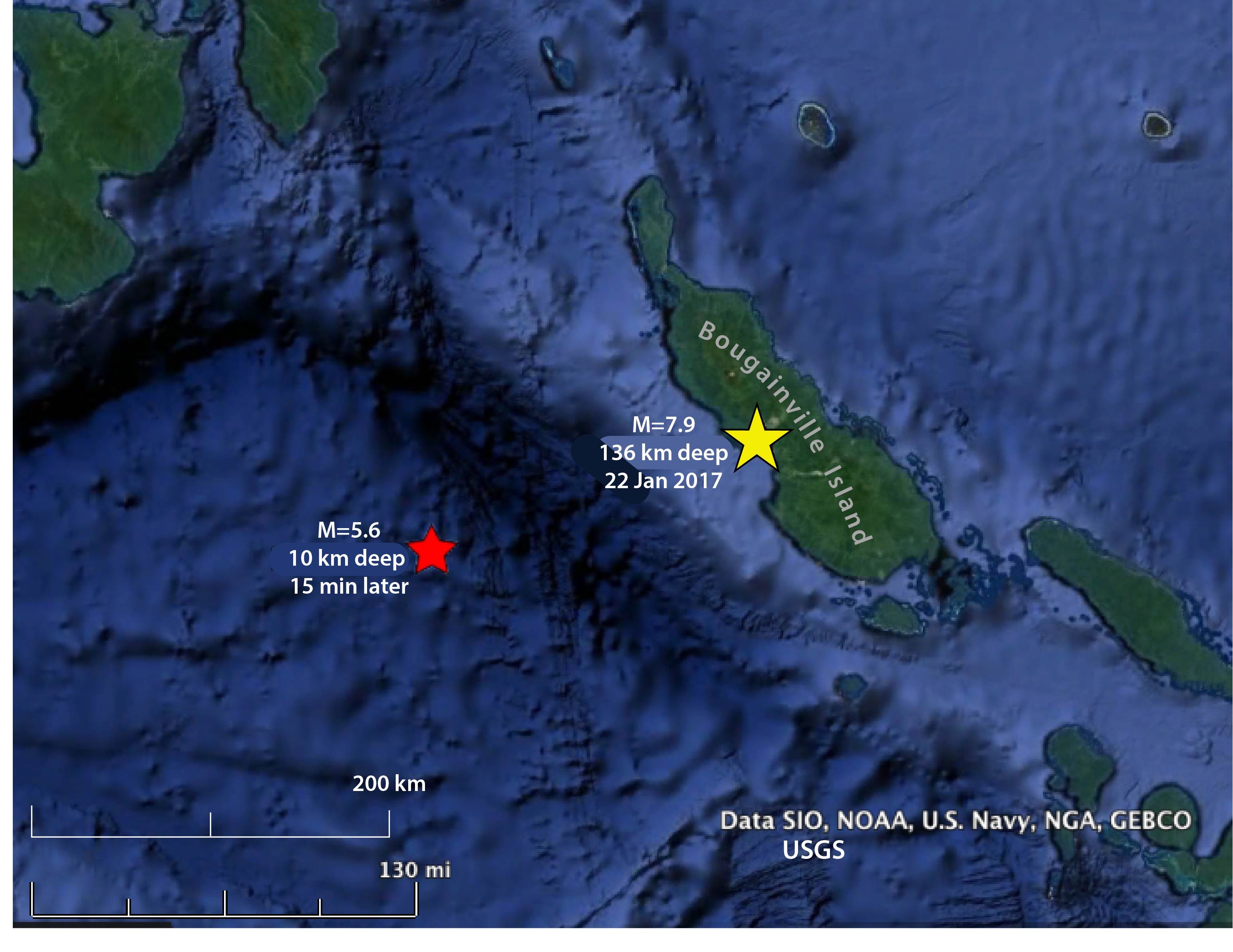By Ross Stein, Temblor
See earthquakes around the world
Perhaps the most remarkable feature of yesterday’s Mw=7.9 mainshock was the occurrence of a M=5.6 earthquake 180 km (110 mi) to the southwest of the mainshock, just 15 minutes after the mainshock struck.

Was the M=5.6 event an aftershock?
The seismic waves propagating from the 136-km-deep mainshock would have reached the site of the 10-km- deep M=5.6 event in about 100 seconds, or 2 min. So, if the M=5.6 was triggered, why the additional 13 minute wait? Perhaps small shocks began as soon as the waves struck, and one of these smaller (undetectable) shocks triggered the M=5.6. Nevertheless, the short time between these events hints at a connection. According to the USGS, one of the two possible fault planes on which the M=7.9 event struck was inclined to the southwest (USGS Fault Planes). If the rupture indeed struck on this plane, then the strongest seismic energy would have propagated parallel to the rupture plane, upwards and to the southwest, reaching the Earth’s surface at about 180 km away, tantalizingly close to the site of the M=5.6 quake. This, and the short time between them, make the strongest case for a causal connection between the two events, although it is far from demonstrated. The global rate of M≥4.5 earthquakes in the 24 hours since the mainshock is about the same as that in the preceding 24 hours, so I see no evidence of global aftershock triggering, which did occur after the much larger 2012 M=8.6 Indian Ocean earthquake.
What does this mean for urban aftershocks?
While the vast majority of damaging aftershocks struck close to the main fault rupture, there is growing evidence of remote ‘dynamic’ aftershock triggering as well. This means that after a large San Andreas, Hayward Fault, or Cascadia megathrust earthquake, for example, the public should be prepared for distant surprises in the minutes to days after the mainshock.
Coming back to the site of the mainshock, Bougainville Island hosts several active volcanoes. It will be fascinating to see if any of these awaken—either in small shocks or fumarole activity—in the next few days as a result of the mainshock shaking.

Was the M=7.9 earthquake a surprise?
Not really. The plate tectonics in Papua New Guinea and the Solomon Islands region in the southwest Pacific looks more like the shards of broken plates. The ~100 mm/yr (4 inches per year) Pacific and Australian plate motion rates, combined with the profusion of faults, makes for one of the most seismically active places on Earth. Here is the setting of yesterday’s great quake:

A very high rate of quakes during the past month is also evident in this region along most of the plate boundaries. A knot of seismicity exists in the region of the mainshocks, but those shocks lie 100-150 km (60-110 mi) west of the M=7.9 event, so it would be a stretch to call these foreshocks.

One can also see Temblor’s Earthquake Forecast (colors) above, which is based on the GEAR model. A M~8 quake is expected at the site of yesterday’s quake about once a lifetime (put another way, with a 1% chance per year). However, the GEAR model is for quakes above 70 km depth, and the M=7.9 lies at 136 km depth.
Sources
US Geological Survey
Robert J. Holm, Gideon Rosenbaum, and Simon W. Richards (2016), Post 8 Ma reconstruction of Papua New Guinea and Solomon Islands: Microplate tectonics in a convergent plate boundary setting, Earth Science Reviews, 156, 66-81, doi: 10.1016/j.earscirev.2016.03.005
- Earthquake science illuminates landslide behavior - June 13, 2025
- Destruction and Transformation: Lessons learned from the 2015 Gorkha, Nepal, earthquake - April 25, 2025
- Knock, knock, knocking on your door – the Julian earthquake in southern California issues reminder to be prepared - April 24, 2025
